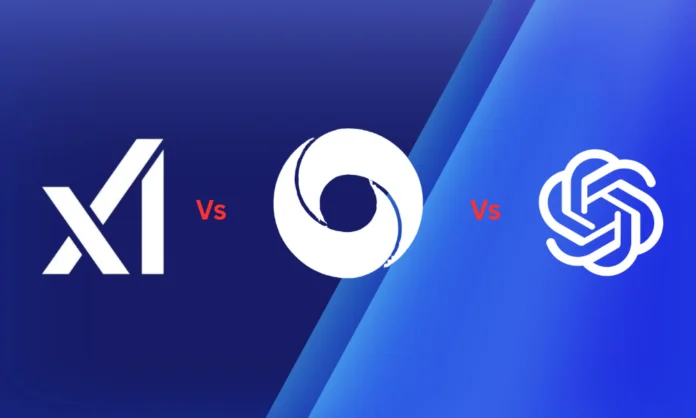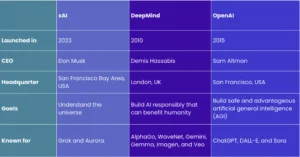Generative AI has advanced unimaginably in recent years, with new players entering the industry every day. Doubtlessly, OpenAI, xAI, and DeepMind have become the key contributors in this field, introducing new features of their AI models every now and then. In short, these firms have gradually become giants, making generative AI more impactful and accessible. But what are the differences between xAI vs. DeepMind vs. OpenAI? Let us explore…
Experts estimate that the global generative AI market has a valuation of $66 billion, which is about to surpass $442 billion by 2031. One of the major reasons for such soaring numbers is quick commercial adoption. Currently, more than 82% of companies worldwide are either using or contemplating using genAI. The role of AI leaders like OpenAI, DeepMind, and xAI is significant for such progression.
Let us thoroughly compare xAI vs. DeepMind vs. OpenAI and find out who has the enhanced competitive edge at present.
Overview of DeepMind:
DeepMind, owned by Google, is one of the leading AI labs at present while comparing xAI vs. DeepMind vs. OpenAI. With the belief that AI has the potential to become one of the most beneficial technologies ever, the firm is determined to construct AI responsibly to benefit humanity. DeepMind is known for creating neural network models for playing video games. Apart from that, it is reputed to build programmatic breakthroughs like AlphaGo, AlphaCode, Gemma, Gemini, and SIMA. It is headquartered in London, UK.
History of DeepMind:
A group of AI and ML researchers, alongside an entrepreneur, started a startup in 2010 in the UK, which we know as Google DeepMind or simply DeepMind today. The main personalities behind the establishment of today’s AI pioneer, DeepMind, are Mustafa Suleyman, Demis Hassabis, and Shane Legg. Initial investors of the startup included reputed names such as Horizons Ventures, Founders Fund, Scott Banister, and even Elon Musk.
DeepMind led remarkable advancements in the fields of mathematics, machine learning, engineering, simulation, neuroscience, and others. Nevertheless, the firm was acquired by Google in 2015 with a deal worth between $400 million to $650 million. Demis Hassabis has been managing the CEO of position since its establishment.
Key Technologies of DeepMind:
DeepMind has introduced several technological advancements in the field of AI and ML since its inception. The following are the most significant ones-
AlphaGo: DeepMind announced the computer Go program that depends on deep reinforcement learning, AlphaGo, in 2015. The innovation holds the reputation of defeating European Go Champion Fan Hui. The upgraded versions of AlphaGo are AlphaGo Zero, AlphaZero, and MuZero.
WaveNet: DeepMind introduced the text-to-speech system WaveNet in 2016. Later, in 2017, it was utilized in consumer applications like Google Assistant.
Gemini: Google DeepMind launched the multimodal AI model, Gemini, in 2023. With the abilities of Deep Research, this model challenges OpenAI’s GPT-4 and xAI’s Grok.
Gemma: Unveiled in 2024, Gemma uses a similar technology as Gemini and represents a series of large language models.
Imagen: DeepMind made advancements in the text-to-image model with the introduction of Imagen in 2022. The later versions of this AI model are Imagen 2 and Imagen 3.
Veo: DeepMind introduced the multimodal video generation model Veo in 2024. Its latest version is Veo2, which can generate 4K resolution videos.
What is OpenAI?
OpenAI is a frontrunner in the AI race between xAI vs. DeepMind vs. OpenAI. The firm is determined to design safe and advantageous artificial general intelligence (AGI). OpenAI has introduced a number of remarkable AI models, including ChatGPT and DALL-E. It also provides application programming interface services as a key contributor to the current AI boom period.
History of OpenAI:
A group of tech entrepreneurs and programmers came together to establish OpenAI in December 2015, among whom Sam Altman and Elon Musk were significant. A capital sum of $1 billion was invested to establish the company. However, till 2019, OpenAI could generate only about 14% of their invested amount, resulting in a non-profit beginning.
Nevertheless, the firm integrated a capped-profit model and welcomed venture fund investment in 2019. In collaboration with Microsoft, OpenAI received an investment worth $1 billion, utilizing Azure’s supercomputing abilities. The period between 2020 and 2023 became most fruitful for the company with the launch of ChatGPT and DALL-E.
Key Technologies of OpenAI:
ChatGPT: OpenAI publicly introduced ChatGPT in 2022. It is currently based on the latest version of the GPT family, GPT-4o.
DALL-E: It is an advanced text-to-image model by OpenAI introduced in 2021. The latest version, DALL-E 3, was unveiled in 2023.
Sora: OpenAI’s superior text-to-video model, Sora, was unveiled in December 2024.
Knowing xAI:
xAI has become a pioneer in AI research and advancement after its launch in 2023. Tech entrepreneur and investor Elon Musk established the firm with the objective of comprehending the universe and creating AI to enhance human scientific discovery. Utilizing massive computational frameworks and complex systems, xAI trains its models. In December 2024, the company announced the establishment of the world’s largest supercomputer, Colossus, within 122 days. It is based in the San Francisco Bay Area.
History of xAI:
Musk primarily launched xAI in March 2023; however, the official announcement was made in July of the same year. The gradual funding sessions of the firm contributed to the significant advancements in the realm of AI. In February 2025, xAI intended to acquire OpenAI with a whopping amount of $97.4 billion. However, it was a failed attempt. In March 2025, the firm acquired the AI-supported video-generation service provider Hotshot. In the same month, xAI took over Musk-owned social media platform X (previously Twitter).
Key Technologies of xAI:
Grok: xAI unveiled the generative AI model, Grok, in November 2024. The versions of this chatbot include- Grok-1, Grok-1.5, Grok-2, and Grok-3. The latest upgrade, Grok-3, possesses advanced reasoning abilities.
Aurora: It is a text-to-image model launched in December 2024 and is integrated with Grok.
Distinguishing xAI vs. DeepMind vs. OpenAI:
Looking Ahead: xAI vs. DeepMind vs. OpenAI!
With the quick progression of AI models, it is evident that we are going to experience several breakthroughs in the near future. We can expect a more human-centric approach in AI models, solving increasingly complicated challenges in the upcoming years. On each occasion, the contribution of firms such as DeepMind can be remarkable.
While comparing xAI vs. DeepMind vs. OpenAI, it is important to state that all the companies intend to develop AI models that can help humanity; however, their approaches differ. Whether it is Gemini, ChatGPT, or Grok, we can solve highly complex tasks with thorough reasoning.
Ready to stay informed in the AI-driven world? Keep visiting us at YourTechDiet!
Recommended For You:
The Convergence of AI and IoT: Revolutionizing Industries for a Smarter Future
Deep Learning and how it is different from Machine Learning?


